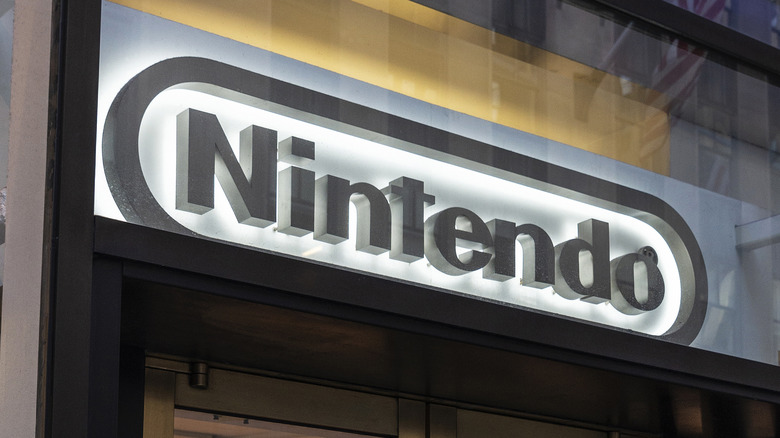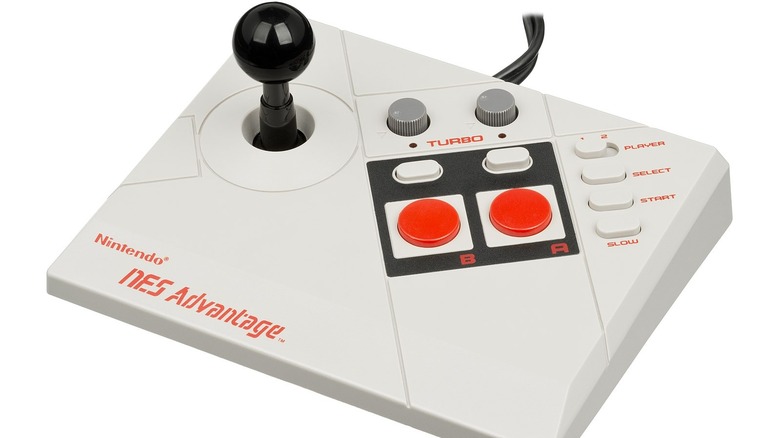This Rare Nintendo Joystick Was Never Compatible With Nintendo Consoles
Besides being known for its iconic characters and some of the best video game consoles ever made, Nintendo also has a reputation for putting out some of the weirdest products and peripherals the gaming industry has ever seen. That includes the infamous Virtual Boy, the oft-forgotten Wii U, the carpet-sized NES Power Pad, and the clunky-but-influential Rumble Pak. But these misfit toys all have something in common – they were made for Nintendo users as first-party products. What might surprise you is that, at one point in its history, Nintendo was making branded peripherals that weren't designed for its own consoles, but rather hardware they had nothing to do with: PC computers.
One of these rare anomalies was a full-sized gaming joystick for Windows and MS-DOS computers: the NJS-3D1, also known as the Nintendo 3D1. You'd have to look really closely or read the labels on the box it shipped in to know this product wasn't compatible with the Nintendo 64, considering its design perfectly fit the aesthetic of the fifth-generation console. This isn't surprising, considering the Nintendo 3D1 was released in 1997 when the Nintendo 64 was dominating both video game sales and the mindset of gamers obsessed with the console's 3D graphics and gameplay that far surpassed the capabilities of the NES and Super Nintendo. The Nintendo 64 was taking the gaming world by storm, which makes it all the more surprising that Nintendo was making a joystick not for its popular console, but for computers it didn't even have a hand in producing.
The Nintendo 3D1
The YouTube channel Michael MJD, which produces videos about vintage computers, consoles, and software, gives a detailed look at the unique Nintendo joystick, pointing out just how unusual such a product is. "Nintendo is known for usually sticking to their own hardware," the host says in a video breakdown of the Nintendo 3D1. "Occurrences of them branching out into other platforms are extremely rare." However, the video notes that though the Nintendo 3D1 is a licensed Nintendo product, the golden seal of quality included, it wasn't manufactured directly by Nintendo. Rather, it was produced by the Laral Group, a hardware company based in New York, which also made a pair of Nintendo-branded wireless headphones for PC around the same time.
The Nintendo 3D1 sold for $69.99 when it was released in 1997. Though the box it came in looked very much like other Nintendo products, its labeling made it clear that the device was for PC only and not Nintendo consoles. It also boasted that the joystick provided computer users "the maximum control your game allows," including "3D rotation mobility" and "slide throttle control." The device was primarily a flight stick as opposed to an arcade-style joystick or thumb stick you would use for traditional platformers, though you could switch modes to a more arcade-style configuration.
The joystick could bend in multiple axes and had four buttons on its handle, as well as four base buttons and a slide switch. Despite being made for Windows 95 and other PC platforms, it evoked the Nintendo 64 aesthetic, with its base the same black coloring as the Nintendo 64 console, and the stick the familiar shade of gray sported by the controller included with the console. The joystick was even branded with the iconic three-dimensional "N" logo of the Nintendo 64.
Nintendo's long history with joysticks
While the Nintendo 3D1 was made for PC gamers only, Nintendo is no stranger to building first-party joysticks for its own consoles. The original NES console, released in 1983, famously used a flat, brick-like controller with a D-pad, but in 1987 – a full decade before the Nintendo 3D1 – the company released the NES Advantage. The arcade-style peripheral was designed to rest flat on a surface and included large buttons and a short joystick knob. Nintendo also famously re-introduced the joystick back into mainstream gaming with the Nintendo 64 controller. Instead of primarily relying on the D-pad, gamers used their thumbs to manipulate the joystick, which made the then-innovative 3D gameplay more intuitive and immersive.
Nintendo kept those joysticks in the design of its subsequent GameCube controller and the nunchuck companion to the motion-controlled Wiimote. The joystick lives on to this day in the Nintendo Switch, the company's current console and its bestselling home console of all time. The Switch uses two individual Joy-Cons, each featuring an analog stick, that can be attached to the sides of the Switch or combined together to form a handheld controller. Nintendo is known for constantly breaking the mold of current gaming trends, and it will be interesting to see how they implement joysticks in future generations of consoles. However, what would be even more interesting is if Nintendo once again makes hardware for computers rather than its own products. It's happened before, so maybe it can happen again.
[Image by Evan-Amos via Wikimedia Commons | Cropped and scaled | CC BY-SA 1.0]

